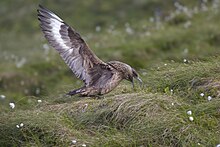Great skua
| Great skua | ||||||||||
|---|---|---|---|---|---|---|---|---|---|---|

Skua on the Norwegian bird island Runde |
||||||||||
| Systematics | ||||||||||
|
||||||||||
| Scientific name | ||||||||||
| Stercorarius skua | ||||||||||
| Brünnich , 1764 |

The great skua ( Stercorarius skua , Syn . : Catharacta skua ), often short but ambiguously called Skua , is a sea bird from the family Stercorariidae .
In Central Europe , the great sku can be observed all year round on the coasts. It is most commonly seen in the period August to November, while observations are less common in the spring. In recent years, the number of observations and the length of time the birds observed has increased. This is possibly related to the increase in the great gulls on the Central European coasts, which the great skua regularly deprives of their food and which thus have a function as " food suppliers ".
description
The great sku reaches a body length of 51 to 56 centimeters and has a wingspan of 125 to 140 cm. The males weigh between 1170 and 1500 grams, while the females weigh between 1300 and 1650 grams. Adult animals of the great skua have gray-brown plumage with rust-red stripes and a black cap. The tail is black-brown with two elongated feathers in the middle. The beak and feet are almost black.
The great sku is a breeding bird of the subarctic and arctic regions of the western Palearctic. The breeding areas are on Iceland , in Norway , the Kola Peninsula , on Novaya Zemlya , on Scottish islands and on the Faroe Islands , where the name Skua comes from ( see Wiktionary ). The wintering areas of this species are on the Atlantic coast. During this time they also reach the coasts of Brazil and Newfoundland and also stay in the western Mediterranean area.
behavior
Non-breeding birds stay at sea all year round and breeding birds outside the breeding season. They are diurnal birds that find their food mainly in coastal waters as well as on the beach or in the immediate coastal area. Their breeding grounds are usually close to large colonies of sea birds such as gannets or other species of gulls. The great skuas reach sexual maturity at the earliest four to five years of age, but often not until six to eight years. They have a monogamous seasonal marriage. Since they are very faithful to the breeding site, they are often mated with the partner of the previous year in the next reproductive period. The clutch usually consists of two eggs that are laid two to three days apart. The incubation period is 28 to 30 days. Both parent birds breed, with the female usually breeding larger. The young birds are looked after by both parent birds. They are fully fledged at around 40 to 46 days and independent after another two to three weeks.
Just like other skuas, this skuas attacks people who get too close to their nest, and in the process flies attacks on the intruder's head. The injuries suffered in the process are painful for people, but not threatening. These birds spend the winter on the open Atlantic .
Diet
The diet consists mainly of fish, which they often steal from other sea birds. They also hunt smaller sea birds such as puffins which they attack in flight just above the sea surface. Larger birds like the northern gannet rob them by attacking the wings with their claws. The handicapped bird falls into the sea and continues to be attacked until it gives up its prey.
Stock and stock forecasts
Duration
The European population was estimated at 16,000 breeding pairs at the beginning of the 21st century. The world population is only slightly higher. The main breeding areas are Great Britain, where about 9600 pairs breed, and Iceland with 5400 breeding pairs. An area expansion is taking place in northern Scandinavia and Russia.
Inventory forecast
The great sku is considered to be one of the species that will be particularly hard hit by climate change. A research team that, on behalf of the British Environmental Protection Agency and the Royal Society for the Protection of Birds, examined the future distribution of European breeding birds on the basis of climate models, assumes that by the end of the 21st century the range of the great sku will increase by a third will shrink. At the same time, the distribution area is shifting significantly to the north and, according to this forecast, only overlaps the current one by 18 percent. The region up to Franz-Josef-Land may represent new potential distribution areas .
supporting documents
literature
- Hans-Günther Bauer, Einhard Bezzel , Wolfgang Fiedler (eds.): The compendium of birds in Central Europe: Everything about biology, endangerment and protection. Volume 1: Nonpasseriformes - non-sparrow birds. Aula-Verlag Wiebelsheim, Wiesbaden 2005, ISBN 3-89104-647-2 .
Single receipts
- ↑ a b c Bauer et al., P. 557
- ↑ Bauer et al., P. 558
- ^ Brian Huntley, Rhys E. Green, Yvonne C. Collingham, Stephen G. Willis: A Climatic Atlas of European Breeding Birds , Durham University, The RSPB and Lynx Editions, Barcelona 2007, ISBN 978-84-96553-14-9 , P. 209
Web links
- Catharacta skua inthe IUCN 2013 Red List of Threatened Species . Listed by: BirdLife International, 2012. Retrieved November 23, 2013
- Photos at www.naturlichter.de .
- Feathers of the skua





